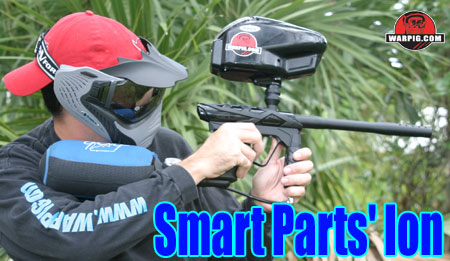  |
|
|
|
|
|
|
  |
|
|
|
|
|
|

What
do you think?
|

Smart Parts' Ion Testing By Bill Mills - Photos by Dawn Mills - Aug 2005 Overview - How It Works - Disassembly - Testing - Raw Test Data The Ion used for review performed admirably on the field. It handled the way one expects an electropneumatic paintgun to handle – easy to rapid fire, relatively quiet, and with little shake or recoil from each shot.
Target groupings of 20 shots taken at microprocessor controlled one second intervals were fired at paper targets from a distance of 75 feet with both the stock barrel and a Smart Parts Freak barrel with .687” insert which matched well to the paint with a typical breath blow fit test. Both test strings yielded 3 shots, which flew high of the target, and similar sized overall groupings. While the groupings were of similar sizes, the one achieved with the Freak barrel appeared to have more of its impacts near the center of the grouping.
For further discussion of the Ion and
this review, Click
Here.
|
| Copyright © 1992-2019
Corinthian Media Services. WARPIG's webmasters can be reached through our feedback form. All articles and images are copyrighted and may not be redistributed without the written permission of their original creators and Corinthian Media Services. The WARPIG paintball page is a collection of information and pointers to sources from around the internet and other locations. As such, Corinthian Media Services makes no claims to the trustworthiness or reliability of said information. The information contained in, and referenced by WARPIG, should not be used as a substitute for safety information from trained professionals in the paintball industry. |